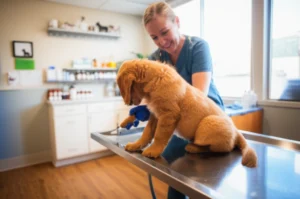Hey there, pet parent. I know how it feels—those big, worried eyes looking up at you, tail wagging, and your heart sinking as you wonder, “How am I going to pay for this?” Vet bills can turn your world upside down, especially when you’re already stretched thin. But what if I told you there’s a way to get help, and you can do it right from your couch with the Pet Fund application online? Yep, no waiting in line, no endless phone calls (well, maybe just one), and the process is pretty straightforward, once you know what you’re doing.
Here’s the scoop: The Pet Fund is a nonprofit that helps cover the cost of veterinary care for pets whose families are in a tight spot. But—and this is a big but—it’s not for emergencies, and there’s a process you need to follow. I want to walk you through the whole thing, step-by-step, honest and clear, because I’ve been there. I’ve helped friends fill out these forms, made those phone calls, and waited for those emails. And I want you to know exactly what to expect, the good and the not-so-good, so you feel prepped and confident.
Let’s break down what this article will do for you: I’ll explain what “the pet fund application online” really means, who it’s for, and what you need to have ready before you start. We’ll go through the process together—because paperwork can feel like a maze, but only when you don’t have a map. I’ll give you tips to make your application shine, remind you of the limits (because no one wants false hope), and point you to other options if this one doesn’t quite fit your family’s needs. And don’t worry—I’ll keep things friendly, clear, and real. No jargon, no fluff.
Sound good? Let’s jump in.
What’s This Pet Fund Anyway?
Okay, so you’ve heard about “pet assistance for low-income families,” maybe a friend mentioned it, or you saw it on a vet’s bulletin board. The Pet Fund is one of those organizations that steps in when you’re facing a pile of vet bills you just can’t manage. They’re a nonprofit, and their whole focus is helping pets get the care they need when families need a little help to make it happen. But here’s the important thing: they don’t cover emergencies. Think of them like your neighbor who’s great at fixing sinks and changing tires—they’re fantastic with the everyday stuff, but if your house is on fire, call 911, not Bob next door.
The Pet Fund steps in for things like surgeries, diagnostics, and treatments that aren’t emergencies but are way beyond what most of us can pay out-of-pocket. Think dental work, or a specialist consult, or medications for a chronic condition. They’re not a quick fix for a suddenly limping pup at midnight—but for those “this needs to happen but we need help” moments, they can be a real lifeline.
So, is the Pet Fund legit? According to their site, they’ve been doing this since 2003, and a quick check online shows they’re recognized by big-name organizations and have a solid track record. If you want to go deeper, check out is the pet fund legit. It never hurts to do a little digging before sharing your info.
Who Can Actually Apply?
Let’s get real: every program has rules, and this one is no exception. The Pet Fund is mostly for folks who are genuinely struggling to cover their pet’s medical costs—think the pet fund eligibility is about demonstrating a real financial need. They’ll usually ask for proof of income, so don’t be caught off guard if you need to dig up pay stubs or unemployment letters.
There’s also a focus on your pet’s medical needs. This isn’t for everyday vaccines or checkups—it’s for those bigger, more complicated treatments. You’ll need a written estimate from your vet, and probably some records to show what’s going on. If your cat swallowed a Lego or your dog broke a tooth playing fetch (why do these things always happen on weekends?), make sure you document it.
Another important note: The Pet Fund deals with routine and non-urgent medical expenses. If your pet needs immediate surgery or life-saving care, this probably isn’t the route for you, at least not right now. But don’t lose heart—there are other resources, and we’ll talk about those in a bit.
How to Actually Start the Process (Step by Step)
So, you think you fit the bill. Now what? Here’s the deal—The Pet Fund is pretty strict about their process. You can’t just waltz in and fill out a form online without talking to them first. It’s like showing up to a party when you haven’t RSVP’d—no one lets you in, and you end up feeling awkward.
Step One: Contact First
You have to reach out before you can get anywhere. Some sources say to call them, but the most current info I’ve seen suggests you email info@thepetfund.com first. In your email, be clear: “Hi, I need help with vet bills for my pet. Can you let me know about your current waitlist and eligibility?” Attach a quick description of your pet’s medical needs and a phone number where you can be reached.
Here’s something I learned the hard way: Don’t skip this step. If you fill out their online application without contacting them first, it might just disappear into the void. Wait for them to email you back—sometimes it’s a bit sluggish, but they will get to you.
Step Two: Gather Your Info
While you wait for a reply, get your paperwork together. You’re going to need:
- Proof of income or some documentation that shows you’re eligible for free pet assistance for low-income families.
- A written estimate from your vet—call the clinic and ask them to put it in writing.
- Your veterinarian’s license number and contact info (this feels a bit intense, but it’s standard for these grants).
- Any medical records or notes that show what’s going on with your pet.
I know, it’s a bit of a scavenger hunt. But trust me, you’ll thank yourself later when everything is at your fingertips.
Step Three: The Actual Online Form
Once you get the green light from The Pet Fund staff, it’s time for the online application. This part is pretty straightforward, but you’ll need a computer with internet and a printer. Yes, a printer. I’m guessing not everyone still has one under their desk, so if you don’t, your local library is probably your new best friend for a couple of hours.
Fill out the form honestly and completely. Double-check spelling—nothing worse than having your pet’s name come out as “Fido-Is-A-Good-Boy” because of a typo. Attach those documents you gathered, and hit submit.
There’s usually a waitlist, and sometimes it’s long. Think weeks, not days. But if you need help sooner, don’t panic—that’s why we’re talking about other options, too.
Step Four: Follow Up and Wait
After you submit, it’s a waiting game. Sometimes you get an automated response; sometimes it’s silence. If it’s been a while and you haven’t heard anything, don’t be shy about sending a polite follow-up email. A simple, “Hi, just checking in on our application—any updates?” is totally fine.
In the meantime, keep an eye on your pet’s condition, and keep talking to your vet. If things get worse, let them know. If you can, ask your vet if they know of any local programs or if they have a payment plan.
Is This Really Worth It?
Let’s be real: Sometimes, you go through all this and still get a “sorry, we can’t help right now.” That stings. It’s normal to feel frustrated—no one wants to jump through hoops just to get a “no.” But I also want to remind you: You’re not alone. Thousands of pet owners are in the same boat, and there are other ways to get help, even if this one doesn’t work out.
Consider these options, especially if you’re looking for pet assistance for low-income families:
- Crowdfunding: Sites like GoFundMe let you tell your story and ask for help from friends, family, and even strangers who love animals.
- CareCredit: This is a special credit card just for pet and human medical bills. It’s not free, but if you pay it off quickly, it can save you from a huge upfront bill.
- Local charities: Sometimes, animal shelters or local rescues have emergency funds. It never hurts to ask.
- Negotiate with your vet: Sometimes, vets can offer a payment plan or a discount if you ask.
The point is, don’t pin all your hopes on one program. Cast a wide net, and be kind to yourself—you’re doing the best you can for your furry friend.
Pro Tips to Make Your Application Shine
If you want to up your chances of getting help, here are a few things I’ve learned from helping friends and family through this process:
- Be clear and concise. When you’re writing your email or filling out the form, stick to the facts. Explain your pet’s situation, but don’t write a novel. They see hundreds of these, so make it easy for them to understand.
- Get your vet involved. Sometimes, a note from your vet explaining why this treatment is important can make all the difference.
- Be honest about your finances. Don’t exaggerate, but don’t downplay it either. These folks are here to help people who really need it.
- Keep records. Save every email, receipt, and note. You never know when you’ll need to refer back to something.
And hey, if you get approved—awesome! If not, don’t blame yourself. These programs are in high demand, and sometimes it’s just about timing.
The Fine Print (and Why It Matters)
Let’s talk about limits and realities, because no one likes surprises. The Pet Fund is a nonprofit, so they don’t have an endless pile of cash. Grants are usually a few hundred dollars—it’s not going to cover a $5,000 surgery, but it can definitely help with a big chunk.
They also have a strict “no emergencies” policy. If your pet needs help right this second, they’re not the right fit. But for those “life goes on” needs, it’s worth a shot.
And remember, the Pet Fund application online is just one piece of the puzzle. There are other groups out there, some focused on specific breeds or illnesses, some local, some national. There are even free pet assistance for low-income families programs in many communities. Don’t be afraid to ask at your vet’s office, your local humane society, or even your city’s social services center.
What If You Need Help Right Now?
If you’re staring at a bill you can’t afford, and waiting weeks isn’t an option, here’s what I’d do: Call your vet and be honest. Sometimes they can work out a payment plan, or they know of a local fund that can help immediately.
You can also try crowdfunding. I know, it feels weird asking for money, but people love animals. Share your story, add a cute photo, and be honest about your situation. You might be surprised how many people want to help.
And if you’re really in a pinch, don’t forget about CareCredit or similar medical credit options. Just read the fine print so you don’t get hit with big interest later.
One Last Thing—You’re Not Alone
I want to leave you with this: Asking for help is hard, especially when it comes to the furry (or feathery, or scaly) members of your family. But you’re not alone. Thousands of pet owners face these same choices every day, and there are people and programs out there who want to help.
The Pet Fund application online is one option, with clear rules and a process that’s manageable if you know what to expect. It’s not perfect, and it’s not instant, but it can be a lifeline when you need it most.
Take a deep breath, gather your papers, send that email, and remember—you’re doing your best for someone you love. That’s what matters.
If you have questions, or if something in this process changes and you’re not sure what to do, reach out. Let’s figure it out together. And if you’ve been through this already—what was your experience like? Everyone’s story is different, and yours might help someone else who’s just getting started.
Stay hopeful, stay honest, and give your pet an extra scratch behind the ears from me. You’ve got this.













